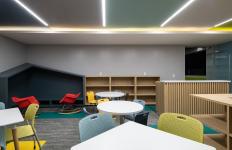The challenge of this project was to conceive new spaces for the student community and adapt them to the existing building to be in harmony with current teaching methods. Yeshiva Keter Torah is the largest Orthodox religious school of the Jewish community in Latin America, with 1,700 students on 4 campuses with an ambitious plan to renovate its facilities that began in 2021.
The remodeling included two complete buildings, corridors, vertical circulations, management offices, teachers' rooms, classrooms, libraries, visual arts, laboratories and access controls. The objective of the renovation was to achieve functional and very flexible spaces in accordance with the new ways of teaching and learning in which connectivity is a vital element that was resolved while respecting strict religious canons at all times.
In the women's building, which receives students from primary to high school, the most radical change was that of the circulations, ceasing to be areas solely for transit and becoming recreational spaces to promote coexistence, the exhibition of school work and facilitate artistic activities.
The main materials used in this building were specially designed carpentry elements in light wood tones, predominantly laminates and melamine to ensure efficient maintenance. The green and gray paints are made of water-based enamel so that cleaning is agile and effective. On the floors, gray porcelain tiles and easy-care vinyl floors were installed.
A versatile area was designed in the library to encourage educational activities to be practical and not just theoretical. It houses physical consultation areas, computer areas, teamwork and lounge spaces to encourage coexistence, collaboration, relaxation and become one of the main meeting points.
In the classrooms, teaching is encouraged not to be frontal, but 360°, using support elements such as mobile bulletin boards and corks, as well as storage furniture that is also mobile. Wood-type vinyl floors were installed on the floors to achieve greater warmth of the space and noise absorption. The color palette changes depending on the type of classroom and more versatile furniture that will encourage teamwork was also considered.
Simple constructive solutions were sought for the men's primary building, it is a semi-open space in which the corridors have a view of the soccer field. The spaces that this building houses are: corridors, vertical circulations, bathrooms, classrooms, library, teachers' room and computer room. The corridors that lead to the classrooms are semi-open spaces that, being somewhat narrow for activities, were used to create work exhibition spaces.
The library was designed as a much more playful environment that, goes beyond protecting the collection, is a point where students can enjoy their free time, which allows them to carry out daily activities, from playing a board game or doing their homework. . It is conceived as a configurable, multi-cultural, interactive and adaptable area that can be modified over time if your needs change.
In the classrooms, a flexible space with mobile furniture was considered that allows it to be adapted to any subject and operate in a 360° format to encourage group activities, leaving behind conventional education where the teacher is always at the forefront and the interaction between students was not an option.
2020
2021
Category: Institutional
Location: Mexico City, Mexico
Start: June 2020
Conclusion: October 2021
Area: 4,510 m2
Photography: Jaime Navarro
Project design: ARCO Contemporary Architecture
Arch. Bernardo Lew
Arch. José Lew
Arch. José Memun
Collaborators: Fernanda Villarreal, Jonathan Herrejón, Adalid Mendoza, Nahela Hinojosa, Guillermo Martinez, Federico Teista, Cynthia Luna, Beatriz Canuto










